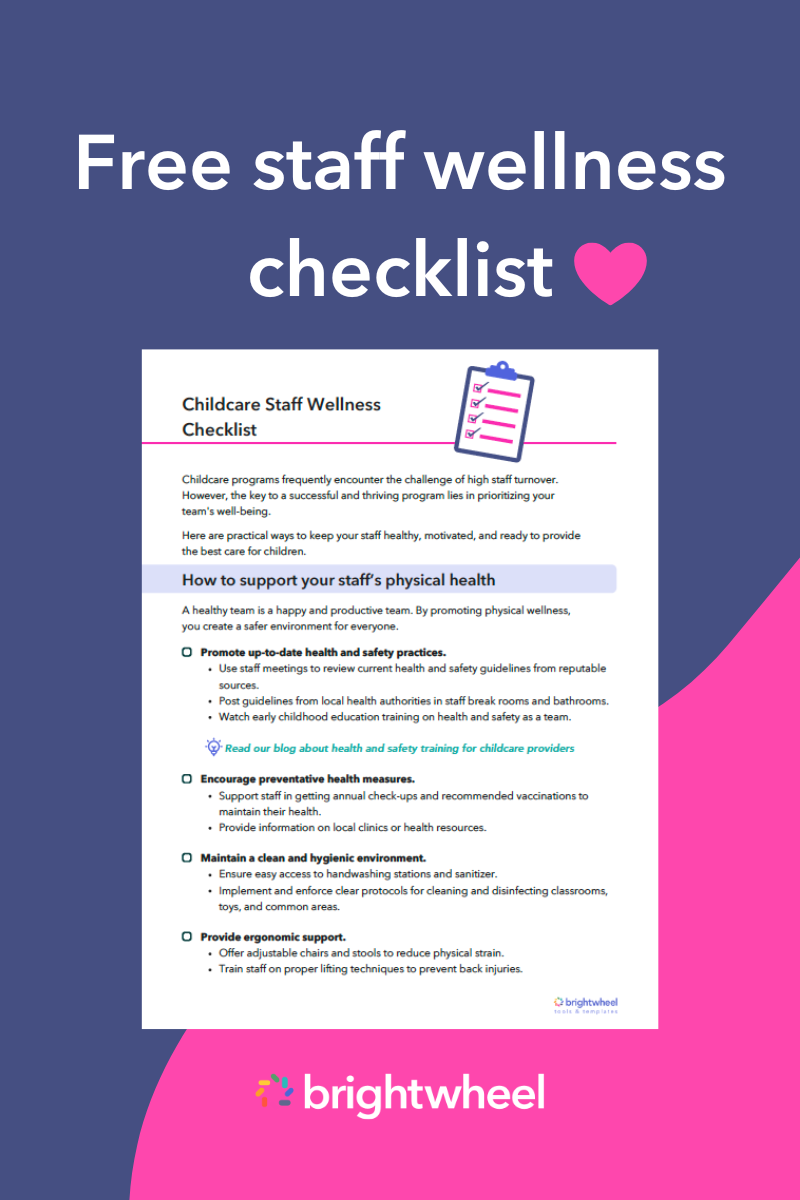As a childcare director or administrator, you know the immense challenges your staff faces. From shifting health regulations to staffing shortages, the pressures can easily lead to overwhelm and burnout.
While self-care is important, community care—the practice of nurturing and caring for those in your community—is equally vital for building resilience and satisfaction. Here’s how you can facilitate it at your childcare program.
Staff Wellness Checklist
A free checklist to promote health and wellness at your childcare program.
5 ways to reduce early educator burnout
You can reduce early educator burnout by fostering a culture of community care. This approach involves creating a supportive environment where staff members feel valued, connected, and empowered to prioritize their collective wellbeing, moving beyond individual self-care to a shared responsibility for mental and emotional health.
1. Offer professional development on wellbeing
Show your staff you prioritize their wellness and careers by offering professional development focused on wellbeing. This fosters a community of care and demonstrates your commitment to their personal and professional growth.
These sessions could include:
- Inviting guest speakers to discuss community care and mental health.
- Watching webinars on topics like stress management and work-life balance.
- Attending local lectures on wellbeing as a team.
- Listening to podcasts or watching TED Talks about mental health together.
- Providing a stipend or time off for staff to learn about community care.
- Empowering a staff member with expertise in wellness to lead a session and share their knowledge with the team.
-
2. Prioritize wellness in your daily operations
To make community care a core part of your program’s culture, it needs to be practiced daily. The more openly you integrate wellness into daily routines, the more natural it will become.
Consider these simple adjustments:
- Hold supervisory meetings while walking outdoors or at a local coffee shop. This change of scenery can act as a mental reset.
- Create a dedicated safe space or staff lounge where educators can connect, decompress, and support one another.
- Add a kudos board for sharing appreciation and encouragement.
- Start a communal library with wellness resources contributed by the team.
- Implement a staff buddy system to help educators build relationships, ask questions, and advocate for their own needs.
3. Demonstrate appreciation for your staff
Showing gratitude for your staff ensures they feel cared for on both a professional and personal level. Staff appreciation activities provide an opportunity for your team to connect without work-related stressors, strengthening your community.
Ways to show appreciation and build community include:
- Hosting a staff potluck or picnic.
- Giving out gift cards to their favorite local businesses.
- Creating a kudos board where colleagues can praise one another.
- Saying "thank you" in person or with a handwritten note.
-
4. Plan regular community care events
While daily practices are crucial, setting aside dedicated time for community care reinforces its importance. Organizing specific events makes it easier for everyone to participate regularly.
Here are a few ideas:
- Volunteer together: Research shows volunteering improves mental health. Serve your wider community at a local soup kitchen, animal shelter, or community center.
- Organize wellness activities: A team walk, yoga class, or other fun team building activity demonstrates your commitment to both physical and mental health and helps keep everyone accountable.
- Start a learning club: Choose a book or podcast focused on topics like leadership, personal growth, or early childhood education, and set aside time to discuss it as a team. This creates a powerful shared experience and encourages professional development.
-
-
5. Facilitate open dialogue about staff wellness
-
For your staff to effectively support one another and reduce burnout, they need to feel safe discussing wellness at work. You can create this environment by implementing clear policies and routines that prioritize mental health.
Two ways to open the conversation are:
- Establish supportive policies: A mental health or wellness day policy guarantees that your staff feels supported by the program.
- Conduct wellness check-ins: Meet with each staff member periodically to discuss their wellbeing, work-life balance, and any other concerns. Keep these conversations separate from performance reviews to focus solely on their health.
How can brightwheel help reduce stress?
Brightwheel helps reduce stress and burnout by automating repetitive administrative tasks. Our all-in-one platform streamlines daily reports, family communication, and lesson plan organization.
With brightwheel, teachers report saving around 20 hours a month on busywork. This gives them more time to focus on what they do best: helping children learn and develop. The platform also makes it easy to share photos and videos with families, leading to more recognition for your staff's hard work and expertise.
Frequently asked questions
Q: What is community care in early childhood education?
A: Community care in early childhood education is the practice of creating a supportive environment where staff members collectively care for one another's wellbeing to combat stress and prevent burnout. It extends beyond individual self-care to foster a shared sense of responsibility for the team's mental and emotional health.
Q: Why is community support important for preventing early educator burnout?
A: Community support is crucial because it creates a network of solidarity and shared understanding among educators facing similar challenges. This connection helps reduce feelings of isolation, provides emotional relief, and builds a resilient team culture where staff feel valued and motivated.
Q: How can I start building community care with a limited budget?
A: You can start building community care on a limited budget by implementing low-cost initiatives like a staff buddy system, a kudos board for appreciation, or holding walking meetings. Additionally, you can utilize free resources like wellness podcasts, TED Talks, or community volunteering opportunities to foster connection and support.

.png?width=208&height=175&name=Childcare%20Staff%20Wellness%20Checklist%20-%20module%20CTA%20(updated%202025).png)
